#mpingo
Explore tagged Tumblr posts
Text
Prince William to sing the royal family at Papa Francis' funeral
For more than 12 years, Pope Francis, Yemwe adamwalira Lolemba pazaka 88, adagwira ntchito molimbika kuti ateteze mgwirizano mu mpingo ndi ogwirizana ndi azondio Royal Royal. Prince William He will go to funeral courts that I will Francis in the royal family, a King Pelhaham Tux Banner told Foox News Digital. In addition, turning to turner, “flags are low in the royalty and in the form of…
0 notes
Text
Mwadzuka bwanji mpingo
Sing’anga/Asing’anga
Ndikumva kukoma (mojo)
Kutawa reza
Gulugufe
Ku ntchito kwathu
Bobo
Nasangalala
Mujende bwino
0 notes
Text
2023 Marta Martins Silva :: Retornados
🇦🇴 Mocubela; Bairro Montanha Pinto; Uíge: Maquela do Zombo; Baia Farta; Malanje; Songololo; Úíje; São Salvador do Congo; Sabondo; praia Morena; Luanda: Bairro da Cuca, Praia das Conchas; Congo Belga; Luso; Moçâmedes; Lubango [Sá da Bandeira]; Caconda, Bembe, Mabubas, Caxito; Cuito [Silva Porto], Cala, Matal; Huambo [Nova Lisboa], Cela Angola, Serpa Pinho, Cuanza Sul: Gabela, Porto Amboim
🇲🇿 Miteda; Muidambe; Nampula; Vilanculos; SOFALA | Beira: Vila Pery; Boane; Mecuburi; Cabo Delgado; Angoche [António Enes]; Moma, Napetil; Marracuene; Quelimane; Tanganhica; Monapo; Nacala; Nagololo; Boane; Nacala; Gungunhana; Chimoio; Morrumbala; Leopoldville; Alto Molucué; Nauela; Guarué; Muxagala; Murralelo; Inaço; Marromeu;
🇵🇹 Sobreira Formosa, Milreu, Sardoal, Sesimbra: Hotel do Mar, Lisboa: Seraton, Ritz, praia Ribeira do Cavalo; Lisbia: Fonte Luminosa, Bairro Quinta das Furnas, Baixa da Banheira; Castelo de Vide; Paião; Vila Flor; Termas Vale da Mó; Odiáxere; Portela; Minde; São João da Talha; Monfortinho; Forras de Algodres;


🇿🇦 Joanesburgo; 🇧🇷 Curitiba; 🇨🇩 Kinshasa; 🇬🇦 Libreville; 🇳🇦 Windhoek; Walvis Bay; Wandouc;
1896 passaporte para África gratuito
1907 abolição passaporte para África gratuito
1957 independência colónias Belgas, Britânicas
1960: >migração colónias (/) condição civil <> motivos comerciais: seguros, agrorural, indústria, serviços públicos;
Angola-Portugal
amiúde; decrepitudes; cacimbo; bailundos; mala de Mpingo; Marmorite; Cotonang; esbaforida; Frelimo; Navio Niasse, Uige; dinamitar, sanzala, sizal, umbundo, genealógico, Acordo Nakuru, Centro Lingua Portuguesa; crispação, resvalou, chapas Lusalite, tabique, tacanha, navio Kwanza, engalanava, Carlos Gil fotografia, Válery Giscard d'Estaing, naperões, Chipenda, Adidos, cós das calças, previdente, bicuatas, chapas de Flandres; óleo de palma, amêndoa de dendém; Navio Silver Sky; Cruz Vermelha; Claudete; caldeirada de cabrito; ostras, burriés, búzios; debandada; turba, vinho de Moçâmedes, barco Mouzinho de Albuquerque, muamba, calulu; Savimbi; aldeia Tchamutete, Casa dos Rapazes, laripo; cal, mercurocromo; fraticida, kimbo; barco Principe Perfeito, açulada, Colégio Viriato, musseque, Saab 99; Renault 12; taipa; adobe; rockets; quitengues; funge



1956 MPLA: Manifesto Escrito
15.03.1961 Massacre UPA; Congo, Cuanza Norte, Luanda; Baixa dd Cassange; bacongos, canhangulos; Carmona;
13.04.1961 Salazar: envio tropas (33m
Transferência Angola-Portugal com pagamento de % a empresa ou autorizado;
1966 MPLA: Leste - Songololo-Malanje
1966 UNITA: 1ª ação
09.1976 IARN Apoio Retorno de Nacionais
pensões
hospedagem de retornados em hoteis
fornecimento: colchão, espumas
crédito instalação, mobilização
Portugal - Moçambique
FRELIMO, GUMO, COREMO, FICO, RENAMO, ZANU; Ford Mondeo 1600; machamba; praia do Bilene; Kruger Park; Loja Brinquedos Bambi; pastelaria Princesa; Sisalz; Operação Nó Górdio; Planalto dos Mascondes; paulidismo; bilharriose; Cahora Bassa; Rio Zambeze; Spinola_Portugal e o Futuro; SNASP; candonga; SHER; Morgane Delaunay; Instituto Algodão; "Renamo com a farda da Frelimo"; 15 anos Guerra Civil; Renamo (Rodésia África do Sul); Alto,Molucué : Zambézia - algodão; empecilho; Felizardo Masseto; cobra venenosa <> superstição;



🔤 cordoer;
0 notes
Text

Decorative Small Round Wood Jars w Pointed Lids Pair 2 Mpingo Rosewood Carved ebay subapete
0 notes
Text
youtube
Let's Pick Up The Pieces - The Firm of Hodges, James, Smith & Crawford (Let's Pick Up The Pieces / Write Me A Letter, 1972)
#Let's Pick Up The Pieces#Soul#Soul Music#Soul Music Songs#Music#Music Songs#1972#Hodges James Smith and Crawford#Mpingo#The Firm of Hodges James Smith and Crawford#Youtube
9 notes
·
View notes
Photo

Homage 2 John Merrick #amboyna #amboynaburl #mpingo #shadowphoto #woodturning #masurbirch #africanblackwood #johnmerrick #ornamentalturning #roseengine #lathework #oneofakind #latheart (at Pacifica, California) https://www.instagram.com/p/CAGreKdjmlT/?igshid=k434e22yr6td
#amboyna#amboynaburl#mpingo#shadowphoto#woodturning#masurbirch#africanblackwood#johnmerrick#ornamentalturning#roseengine#lathework#oneofakind#latheart
2 notes
·
View notes
Photo

Latin Percussion Grenadilla Wood Clave & King Klave (Models LP261 & LP597) @lpmusicofficial https://lpmusic.com #latinpercussion #clave #claves #latinpercussionclave #lpclave #latinpercussiongrenadillawoodclave #lpgrenadillawoodclave #latinpercussionkingklave #lpkingklave #grenadilla #dalbergiamelanoxylon #africanblackwood #mpingo #woodofeasternafrica #fiberglass #madeinmexico https://www.instagram.com/p/Cnwnv1BuNjl/?igshid=NGJjMDIxMWI=
#latinpercussion#clave#claves#latinpercussionclave#lpclave#latinpercussiongrenadillawoodclave#lpgrenadillawoodclave#latinpercussionkingklave#lpkingklave#grenadilla#dalbergiamelanoxylon#africanblackwood#mpingo#woodofeasternafrica#fiberglass#madeinmexico
0 notes
Photo
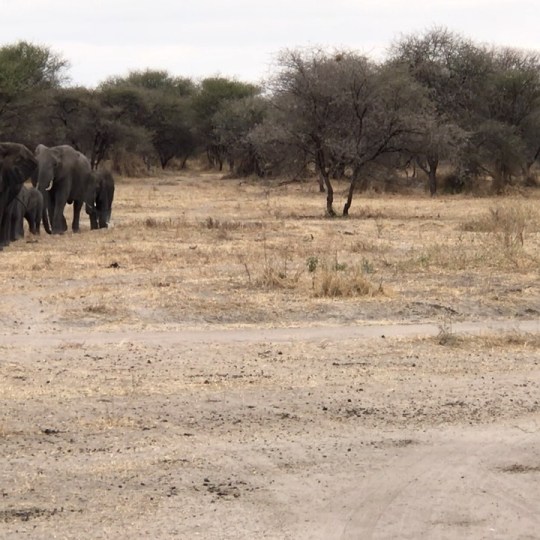
Another happy matriarchal herd grateful for mud, trees & water. #africa #elephants #family #matriarch #margoreylives #tanzania #mpingo https://www.instagram.com/p/CSTGB79rFmx/?utm_medium=tumblr
0 notes
Text
African Black Wood Jewelry Is The Perfect Gift For Her
There is an intertwined connection between apparel and jewelry. Jewelry amplifies the sweetness of garments and enhances the personality of the individual. Traditional african jewelry is out there during a wide selection, and you simply need to select the piece that enhances best together with your attire. The fashion-conscious people keep checking out some unique collections, and therefore the designers put efforts to bring some innovations for them.
Jewelry features a rich history. It’s evolved over the years from a logo of status and wealth to a method statement. Sometimes the designers take inspiration from history to form their collection and convey the trend back. While, in some collections they introduce their own innovation. Many glorious ideas like the use of stones, leather, and feathers have come up from the designers. Using wood is additionally a replacement step towards jewelry creation. Some expensive wood types like African blackwood, Purpleheart, Rhodesian Teak, and Imbuia wood are imported, by the designers, to finish their collection.
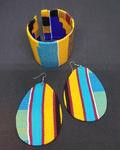
The Blackwood from Africa is that the costliest hardwood within the world. In Tanzania's language (Swahili), it's also referred to as Mpingo. Tanzania may be a South African country where Mpingo grows in great quantity. The particular color of the wood isn't black, and it ranges between brown, dark violet, and green. A grade wood will offer you a real black look. The wood has high commercial value and versatile application. It’s utilized in musical instruments.
The jewelry pieces made from stabilized wood with a mixture of precious gemstones and metal could become the simplest gift for your next anniversary or her birthday. It’s natural jewelry, and since it's made from natural wood, there are not any chances of skin allergy. There are designers in Cape Town who design pieces made from quality wood through the unique stabilization process.
The African blackwood jewelry can become subsequent addition to your wife's collection. She is going to surely get impressed with the unique combination of gemstones and wood. The simplest thing about this collection is that the pieces for men also are available. You’ll purchase authentic african jewelry online for yourself. They’re perfectly designed to suit the adventurous nature of a person.
The designs are elegant and may be used on a routine basis. You’ll contact the designers to form a customized piece for expressing the intimacy of your memorable moments. Select the wood, gemstone, and metal of your choice and therefore the designers will integrate them into the simplest possible piece.
For more info :- African jewelry Online store USA
Visit Us Social Media Update’s :-
https://www.instagram.com/shopvitaltreasures/
1 note
·
View note
Text
Kufika (Arrival)
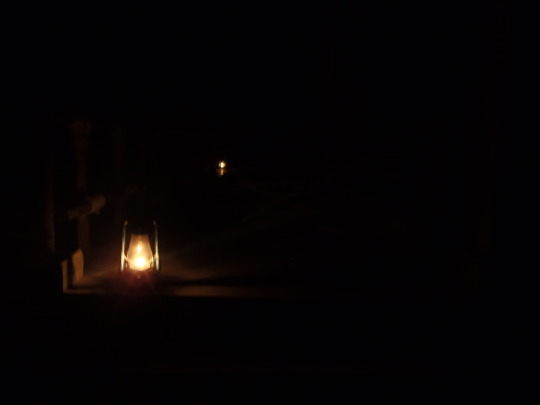
There were a multitude of thoughts that went through my head when I was waiting at the airport, about to depart for a year in a very foreign place. My family finally left, after a series of tearful farewells. I cleared security and ate a bagel. I organized and reassembled my belongings and made sure my belt and shoes wouldn’t fall off. Then, I was finally alone with my thoughts, at the brink of a descent into a new adventure that might very well change my life forever.
Chief among my thoughts was surprise. Despite the fact that I signed up for this trip more than a year before this day arrived, and I spent the better part of five months preparing, both mentally and physically, for whatever was to come, I lacked the existential ability to understand that the day of departure, for weeks circled on my calendar, had arrived. A mistake, perhaps? Surely just a mislabeling by the people who print the calendars. Or perhaps this was all an elaborate exercise to train my loved ones to prepare for an emergency departure should a drug cartel or shadow government set its sights on me. Yes, a mistake! “Good show, everyone. Back in the car! Just toss all the luggage in the garage and throw a tarp over it. Let’s never speak of this again. What’s for lunch?”
The true surprise was that I hid the reality of the departure from myself for as long as possible, instead focusing on the preparations for the trip: the vaccines (“These will keep me safe when I go on safari, and swim in beautiful, flowing rivers,” I said, as the nurse rolled her eyes); the purchase of vast quantities of clothing (“I bet doing laundry is going to be an unique and interesting experience”); stocking up on camping and survival equipment (“This thermal sleeping bag, first-aid kit, and oversized knife will keep me safe, warm, and happy”); and the good-bye parties (“Yes, yes, I’ll do my best not to come home with any African wives, but you know it just can’t be helped, what with these good looks of mine”). What stood between the months of preparation and the day of departure was the stark difference between the known, the familiar, the comfortable and the vast and yet-to-be determined future. I was about to embark, truly, on a journey into the unknown.
Intertwined with my surprise that this was all actually happening, that my family has really left the airport and wasn't going to turn around in a fit of rage and demand to extricate me from this calamitous situation into which I’d somehow become enmeshed, was the cold drip of a slowly intensifying panic. We aren’t talking junior varsity��type panic, either. This is Friday-night-deep-in-the-heart-of-Texas-varsity panic. This panic was scouted since it was 16. This panic was going pro. It was reminiscent of those grimly vivid anxiety dreams in which the very thing you’ve dreaded is coming to pass and there is nothing you can do to stop it. I had to give up control to the great wave of the universe and let it push me toward wherever I was going.
Yes, I tricked myself into thinking what a grand adventure a year in Tanzania would be, and everyone for some reason listened to me and let me get on with it. If you ever find yourself in this situation, here is my advice: sit in one of those slouchy, faux-leather airport chairs, arrange all of your bags in a pyramidal structure within your immediate reach, close your eyes, and make a mental list of all the things for which you are thankful. Try not to think about how much you will miss them when you finally yield to the as-yet-unknown-to-medicine innard-consuming parasite that you will undoubtedly contract. Positive thinking in these situations is key, as I will demonstrate again and again.
While you meditate on your future, a number of other, somewhat more practical, thoughts will vie for space in the tumult of your mind: “Why did I pack so much? Surely I won’t have any use for seventeen pairs of underwear and three bath towels. I’m sure I can just pick up a new one if one becomes soiled at the local grocery shop, along with some cough drops and a decent bottle of Scotch.” Following this might be, “Why did I pack so little? I need at least two good frying pans, and seventy-five more toothbrushes. Damn those TSA guys for making me throw out the Wi-Fi router and my French press.”
At various intervals, other thoughts will attempt to intrude: “What does CPR actually stand for? Does my vaccine for yellow fever cover other colors of fever, or just yellow? When they said to be ‘conversant’ in Swahili upon arrival, does that mean stop-and-chat or full-on debate and interrogation techniques? Why the hell will I need hiking boots? What if my roommate is a mouth-breathing racist who doesn’t wash dishes? Who is going to file my taxes?” You have a few connecting flights to take before you get to New York to meet up with the twenty strangers who will form your network of friendship and emotional support for the next twelve months, so focus on one thing at a time. Take as many deep breaths as you can manage without passing out, put one foot in front of the other, and count down the minutes until you board the international flight and the booze is free. This is good advice. Trust me.
***
After a thirty-six hour journey that commenced with drinking coffee in Buffalo; enjoying celebratory beers in the sterile and characterless halls of JFK’s international departures terminal; watching the sun rise over the Swiss Alps; flying into Nairobi, Kenya, over a vast wildlife park and trying to locate zebra and giraffe from the plane; and watching brightly lit ships cross the dark ocean near Zanzibar, I arrived in Tanzania. During the long layover in Zurich, verdant, rolling Swiss hills framed the rising sun from the airport’s windows, and I was tempted, more than a little, to stop off there, find a stylish hotel next to a medieval pub, and put an end to this crazy African adventure before it had begun. (Hopefully it would be the very same hotel in which my stunning and brilliant flight attendant happened to be staying, to provide an opportunity to embarrass myself in multiple languages.) I didn’t, though. Otherwise this book wouldn’t exist and I’d be living happily in Switzerland, writing about chocolate, mountains, and my love for cozy sweaters.
The only hiccup occurred in Zurich immediately upon boarding the Swiss Air flight to Dar es Salaam, when I noticed that the entertainment system on the plane wasn’t working in some rows. The thought of an international flight without the sedative of television was unsettling. A beleaguered flight attendant paced back and forth between complaining customers, murmuring quiet apologies. To compensate, I took to narrating in my head the plot of the show being watched by the woman three rows ahead of me, where the TVs were working, while opening the first of many tiny gin bottles. Finally, someone in the back of the plane hit the power console with a brick and the screens jumped to life. Fourteen hours, four movies, and many tiny gin bottles later, I arrived in Dar es Salaam, Tanzania.
The Dar es Salaam airport, which was more the idea of an airport than the actual thing, was small and confined, with one ticket desk and one baggage claim. After searching for a few minutes, I found a bathroom to which the door didn’t close all the way. Everything, including the walls and ceilings, looked to have been lifted directly from a mid-century American shopping mall. The customs process led to our group of twenty volunteer teachers, with me as a representative, hastily presenting a stack of passports and about $1,000 in brand new US $50 bills to an amused official to pay for our Tanzanian entry visas. I stood warily next to the counter, keeping a respectable distance but quietly watching to ensure our passports were properly returned with stamps and visas. They were, and everything was in order. Suddenly, we were allowed to enter the country. Lesson One: Somehow, Tanzania has a way of evening out the most chaotic exchanges, and things wind up right in the end. But I didn’t know that at the time.
From there, we made our way outside into the late-evening Dar heat. The sky was streaked with the last vestige of the day’s light. What a sight we must have made to the cab drivers, shopkeepers, and native travelers, with our bags and backpacks and hiking boots and walking sticks and safari hats. You can’t help but look out of place when arriving somewhere after a long plane ride, especially one that traverses multiple time zones and countries. A great machine picked you up, whisked you away for a period of hours or days, and spat you out on the flat surface of somewhere else. You practically reek of foreignness. Because the actual experience of air travel is mostly anodyne and repetitive, with most trips seeming identical from the inside of the plane, arrival in a new place becomes even more jarring, like waking up from a strange sleep in a new place. “How did I get here? Where am I and what am I doing? Why is it so hot?”
The air was cooler immediately outside the airport’s entrance, laced with flowers and far-away smoke and the sweet evening scent of fading heat. The exterior courtyard of the airport was ringed with Plexiglas stalls selling snacks, SIM cards, and postcards of Mt. Kilimanjaro. Small kiosks with colorful signage offered money exchange and safari tours. It was a place that, though I could not know at the time, I was destined to spend many more hours before my journey was complete a year later. A group of cab drivers stood near us, probably trying to decide if we needed rides and if it was worth trying to approach us. I was instantly on guard, a product of exhaustion and the defensive instinct that kicks in upon arrival in any big city.
One of the drivers, whose badge was visible on his Manchester United jersey, approached me and greeted me in English. “Looking for a ride?” he asked. I explained that we were waiting for transportation, speaking slowly and probably sounding like an idiot. I had no idea how my speech patterns would be understood, if at all, so speaking clearly seemed a good plan. The driver nodded, in a friendly way, and continued standing next to me.
“Where are you from?” he asked.
“America,” I replied. “We are teachers.” He nodded again.
“Where are you going?” he asked.
“All over,” I said. “We don’t know yet.”
He seemed confused at this and didn’t reply, probably thinking I was a bit crazy in addition to being rude, but he stood next to me for a moment longer. I’m sure he was trying to get a fare, yes, but he was also trying to be friendly and to welcome us to his country. He held out his hand and I shook it, bringing an end to our conversation. He walked back to the group of drivers and commenced an animated discussion with them in Swahili. I was left feeling very out of place. Not for the last time.
After we stood around nervously for about twenty more minutes, sweating in the unfamiliar heat and watching people come and go with the jealousy that belongs only to outsiders, our Field Director arrived to collect us in a bus with Mustafa, our driver, and we piled all of our bags into the back. Think twenty people multiplied by about 100 pounds of luggage per person—a veritable mountain. I was surprised the bus didn’t tip over. Not for the last time.
The journey from the airport in Dar to Mpingo Farm Stay, about 24 miles (38 km) outside the city, was one of the most surreal I have ever taken. The combination of exhaustion, adrenaline, darkness, and the intoxicating smells and glimpses of an unfamiliar world, created a panorama that will never fade from my memory. Surrounded by my companions, who were newly energized by our arrival, I sat crammed into a tiny bus seat with my forehead pressed against the window, trying to fight off my body’s nervous energy and find some sleep. I settled instead for staring out the window at the unfamiliar tableaux that passed by in islands of light. These visions were surrounded by shadows that seemed deeper and more mysterious than I’d ever seen. The bright lights of the airport quickly faded into the enveloping darkness as we drove down a wide highway lit only by dim street lamps. In the darkness, I saw countless people walking along the sides of the street, in pairs and groups, riding bikes, sitting and eating. It looked as busy as a Sunday morning.
Tiny shops, built from concrete blocks in the dirt and mud at the road’s flanks, dotted the night with flashes of light as we passed. I saw barber shops with neat, hand-painted signs; tiny hair salons with long strings of beads covering the door; shops the size of phone booths flanked by bags of grain and cement and oil drums, generators, symmetrical mountains of fruits and vegetables, soccer jerseys, bright bolts of cloth and fabric, and stacks of colorful plastic buckets of all sizes. Other shops were surrounded by wooden headboards and bed frames, unvarnished chairs and table legs, and piles of luggage and suitcases. Small bars and open-air restaurants with glowing television screens and neon beer signs were ringed by plastic chairs set in pools of eerie, hazy light. A solitary man walked down the sidewalk holding a tray of gum and cigarettes for sale, lit by a single candle. A pool table was illuminated by a lantern hung from a tree, around which dozens of people were gathered, some observing, some discussing, some dancing.
Candles lit tiny spheres of night, illuminating fleeting scenes and leaving me with only parts of a large whole. My exhaustion gave way to confusion, and the passing heads and bodies silhouetted in pools of candlelight became scenes from a strange night market in a new, post-apocalyptic world. Hovering somewhere between exhaustion, panic, and relief, I watched as we passed motorbikes, cars, trucks, three-wheeled motorcycle taxis called bajajis, and a multitude of people standing, walking, eating, drinking, fighting, singing, and dancing in the darkness. I felt as if I’d stumbled into a play with no audience. It was both oddly familiar and astonishingly new, as if remembered from a dream.
#Tanzania#Dar es Salaam#This Is Not a Safari#Travel blog#Travel memoir#travel#travel writing#Africa#Mahenge#Iringa#Mpingo#volunteer#ESL#ESL teacher#worldteach#book
0 notes
Photo

Just finished mounting and framing a painting for a client. It is solid Mexican Kingwood (Camatillo) with hand carved corners of African Blackwood (Mpingo). Shout out to @exotichardwoods for the amazing Mexican Kingwood. Also @bellforestprod for the awesome African Blackwood. #lukadesignworks #woodworking #painting #frame #mounting #mexicankingwood #camatillo #africanblackwood #mpingo (at Gardena, California)
#camatillo#mexicankingwood#painting#mounting#africanblackwood#lukadesignworks#mpingo#frame#woodworking
0 notes
Photo

We come up with some fun projects to work on but I have to admit that we had fun with this one! This here is a special box we designed and sent out to @joemanganiello and exhibits the ultimate in our customization options. What you see see here is a set of Red Snapper Gator Jaw Bone inlaid with Brimstone with a special Bloodwood Box. The box is marquetry inlaid with a Bloodwood dragon head, Mammoth Tusk Ivory horns, Mpingo background and Brimstone summoning circle. That there is a whole lot of gorgeous material crammed into one epic package! Check out the link in our bio for our Red Snapper Gator Jaw Bone! #dice #diceporn #woodworking #arkhanthecruel #arkhan #tiamat #critrole #criticalrole #isitthursdayyet #dungeonsanddragons #dnddice #ttrpg #dandd #polyhedraldice #gator #louisiana #bayou #alligator #brimstone https://www.instagram.com/p/Bz86vMnh3Jv/?igshid=t53ewuepgzrw
#dice#diceporn#woodworking#arkhanthecruel#arkhan#tiamat#critrole#criticalrole#isitthursdayyet#dungeonsanddragons#dnddice#ttrpg#dandd#polyhedraldice#gator#louisiana#bayou#alligator#brimstone
1 note
·
View note
Photo




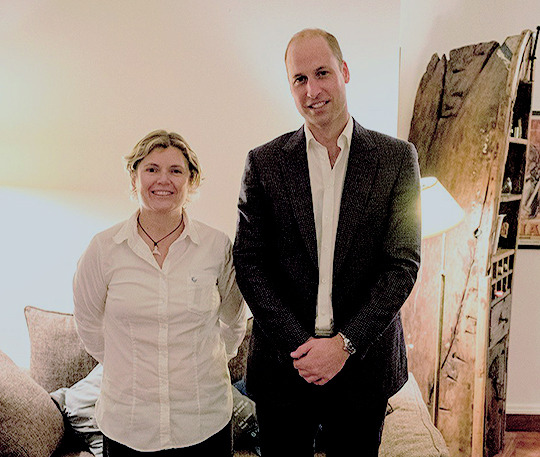
The Duke of Cambridge was received by The President of the United Republic of Tanzania at the State House, Dar es Salaam, Tanzania on September 27,2018.
At a UKinTanzania reception in Dar es Salaam, The Duke of Cambridge met people working in conservation and to #EndWildlifeCrime.
The Duke of Cambridge later visited the Marine Unit and Port in Dar es Salaam.
At Dar es Salaam Port The Duke of Cambridge saw some of the challenges faced by port operations in combatting the illegal wildlife trade.At the port of Dar Es Salaam The Duke of Cambridge, United4Wildlife President, saw how UNODC is working to stop the illegal exportation of poached animal products such as ivory and rhino horn.
The Duke of Cambridge afterwards visited the ivory stockpile at Mpingo House and then he visited the rhino sanctuary at Mkomazi National Park.
31 notes
·
View notes
Text
youtube
Write Me A Letter - The Firm of Hodges, James, Smith & Crawford (Let's Pick Up The Pieces / Write Me A Letter, 1972)
#Write Me A Letter#Soul#Soul Music#Soul Music Songs#Music#Music Songs#1972#Hodges James Smith and Crawford#Mpingo#The Firm of Hodges James Smith and Crawford#Youtube
6 notes
·
View notes
Photo

Ornamental Boxes made of #Kingwood #mpingo #bamboo #betelnut . #holtzapffel #ornamentalturning #roseengine #guilloche #lathe #woodturning #woodboxes (at Pacifica, California) https://www.instagram.com/p/Bp2RmO2A2fL/?utm_source=ig_tumblr_share&igshid=1a0q9j30uyipc
#kingwood#mpingo#bamboo#betelnut#holtzapffel#ornamentalturning#roseengine#guilloche#lathe#woodturning#woodboxes
1 note
·
View note
Text
KIPEPEO HOUSE

Intro
Kipepeo is a Swahili word meaning butterfly. A butterfly flies free after it has been nurtured within the safety of a cocoon protected from the ravages of the outside world. This description of a butterfly from google describes Kipepeo house for what it visually is. Located in Malindi Bay, at the mouth of the Galana River, lying on the Indian Ocean coast of Kenya is Malindi town. It is 120 kilometres northeast of Mombasa. A multicultural and strategic centre known for trading and skilled craftsmen, it is characterised by a savanna tropical climate and laid-back atmosphere, fresh seafood, pristine beaches, and Swahili-inspired architecture. Kipepeo house, their intervention zone, is situated in the mainland, which is a privileged location in the town. The architect worked with the owner to create a building with minimal environmental impact, by adapting to the land's natural slope, and by using locally available materials and know-how. Kipepeo is a development that prides itself in its innovative architecture, showing its attachment to the Kenyan Coast by borrowing inspiration from the rich Swahili design. The house is committed to harmonising the past, present and future.

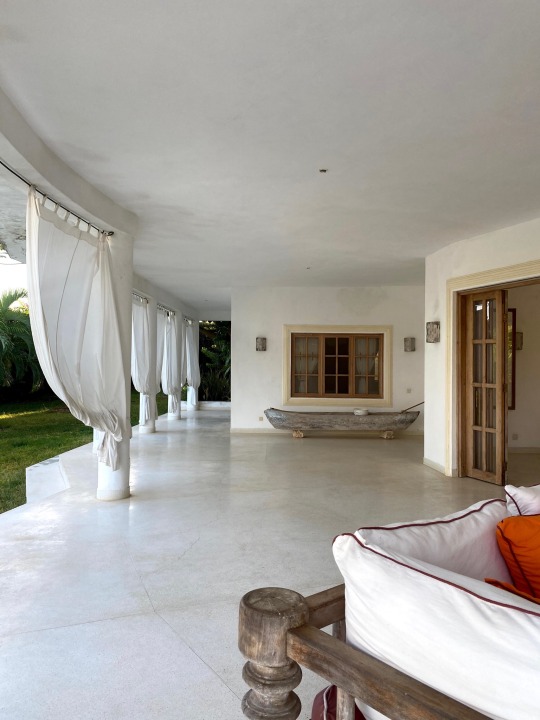
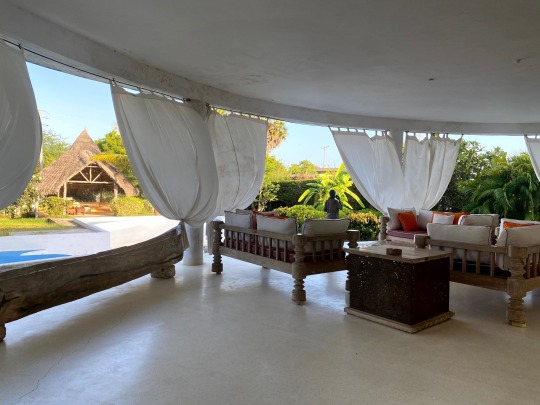

Once the functional disposition of the house was determined - an investigation on the building skin ensued. The in-depth research involved the understanding of: Swahili ventilation techniques; closing systems of lattices; in and out spaces; use of local materials; privacy gradient; climate control and highlights of view towards the main land. The outer shell of the house was designed following a study of the butterfly's shape. It serves for the privacy in relation to the surroundings, and for the filtered, natural light they wanted for the house. Sometimes there's a direct limit of the internal house spaces, the shell is at other times a first filter of sunlight and heat, doubled by internal handcrafted wood-lattice shutters. In this way, light is generous and heat is broken down.
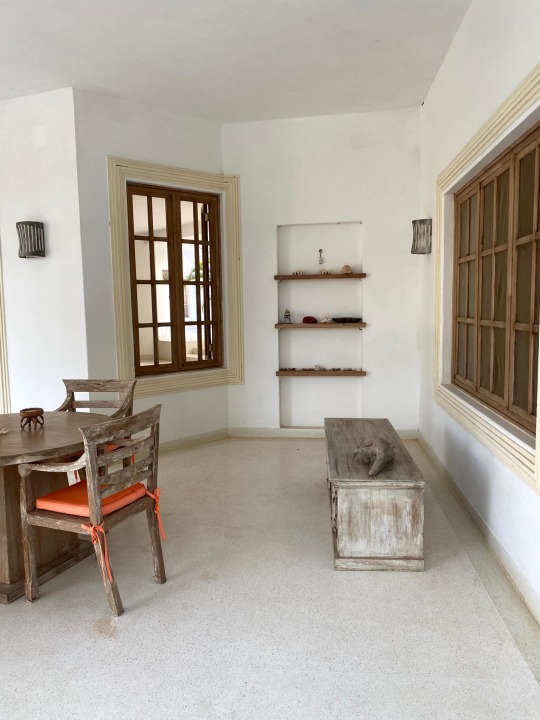
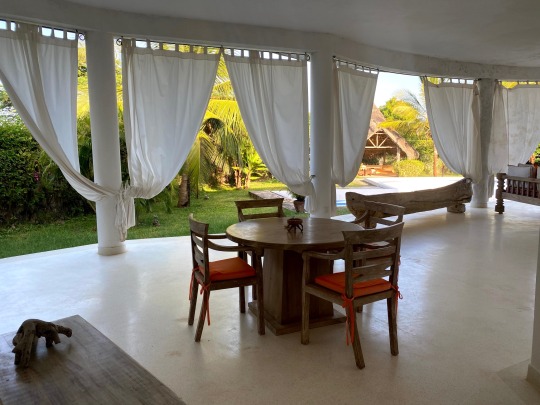
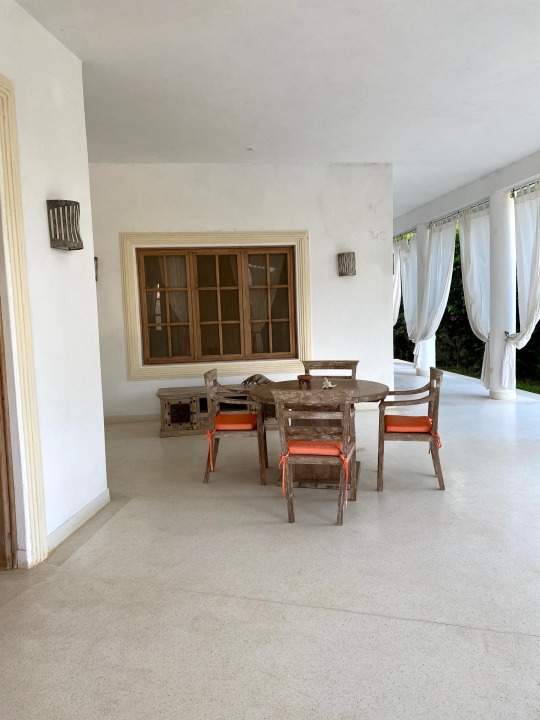
The interior consists of edges and openings; transitional spaces; spatial layers; courtyards; surprise and delight; materiality; light and shadow. This was done after analysis of the site and research of Swahili cultural heritage. In addition to white plaster finishing, the project used mtomo finish, a coral stone cladding technique original to Lamu that helps keep thermal capacity thanks to the porosity of the coral stone. Wood work was realised entirely thanks to outstanding hand carvings by local artisans from Malindi and Lamu. Furthermore, artisans produced in-situ terrazzo for the flooring of the patio house.
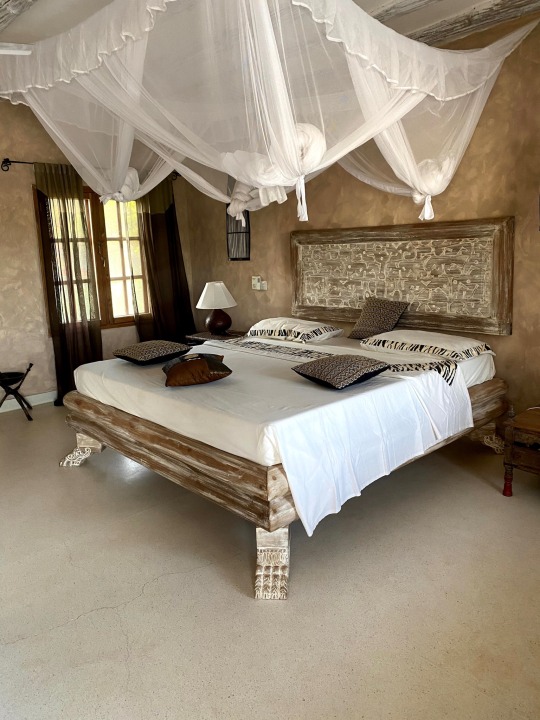
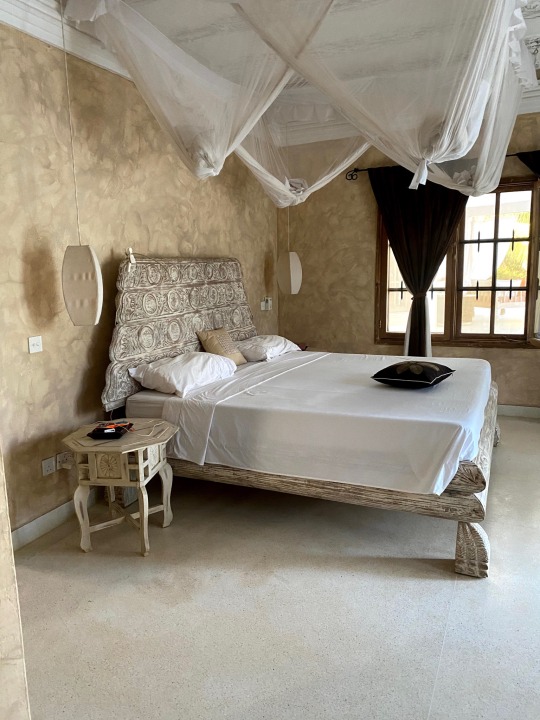
The furniture is characterised by Malindi's extraordinary and unforgettable woodcarving which is not only an art form, but also an important source of income. The most popular items include doors, headboards, chairs, chests and tables. Lamu's carved doors are large and impressive and give status to the owner. Woodcarving was first introduced by Hindu craftsmen, who were careful to only use floral designs so as not to offend their Swahili or Arab patrons whose strong Islamic beliefs prohibit the making of images and idols. Besides its magnificent carved doors, it also consists of the high-backed chair, the kiti cha enzi (literally ''chair of power'' commonly referred to as kiwi cha mpingo, the ''ebony chair''). It is striking for its angular design and hard wood (often ebony), elaborate string panels, delicate ivory or bone inlay. The kiti cha mpingo is now considered a collector's item. Beautifully carved beds are prized prestige items that have been used in the Interior as well. Most of the styles seem to have been adopted from India, and include the pili pili and samadari beds. These turned wood and lacquered beds were very fashionable, but have slowly given way to modern furniture. The older homes of the island and Lamu Museum showcase some of these more intricate styles. Coffee tables and lighting fixtures have been replaced by wooden chests ornately decorated with brass, often referred to as ''Zanzibari chests'' which were once highly prized among Lamu's wealthy inhabitants. Smaller ones were used to keep clothes. Also, included are mats and lighting fixtures made of woven palm fond.
Next time you visit Malindi, be sure to book your stay at Kipepeo house if you're looking to have that homey vibe with a Modern Swahili touch. ;)
The wandering architect, creativity in every exploration...
1 note
·
View note